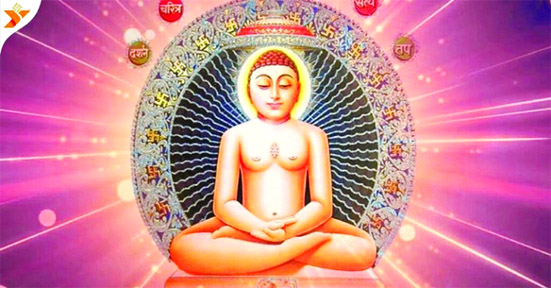
Mahavir Janmakalyanak is the main festival of Jainism. Mahavir Janmakalyanak is also known as Mahavir Janma Kalyanak Divas. Lord Mahavira is the twenty-fourth and last Tirthankara of Jainism. This festival falls in the month of March and April and according to the Jain calendar, the 13th ‘Sud’ day of Chaitra month is also known as ‘Veer Teras’. Mahavira was named “Vardhaman”, which means “one who grows” as the prosperity of the kingdom increased at the time of his birth. Mahavir Swami was born as the son of King Siddhartha of Kundagrama, Ikshvaku dynasty and Queen Trishala.
Lord Mahavira Birth
Lord Mahavira was born about two and a half thousand years ago in Kundalpur in Chaparan district of Bihar, some such historians believe and some believe that Mahavira was born in the democratic state of Vajji and its capital was Vaishali. Lord Mahavira was born 599 years before Christ. At the age of 30, Mahavir ji left the world in a state of disenchantment and after taking sannyasa left the path of autism. After 12 years of hard penance, he received only knowledge, after which he spread knowledge in Samvasaran. At the age of 72, he attained salvation from Pavapuri.
Lord Mahavira was the twenty-fourth and last Tirthankara of the Jain religion. According to Jain philosophy, all Tirthankaras were human beings but they have attained a state of perfection or enlightenment through meditation and self-realization.
They are the Gods of Jains. The concept of God as a creator, protector and destroyer of the universe does not exist in Jainism. Also, the idea of God’s rebirth as a human being to destroy the devil is not accepted in Jainism.
The legend says he spent nearly twelve and a half years in meditation to attain spiritual knowledge and to be free from all desires, feelings and attachments. He learned to be equal towards everyone including animals.
He avoided hurting anyone with or without any intention. After serving the severe punishment, his powers were fully developed. Hence, he was given the name Mahavir meaning brave and courageous.
Once he attained the knowledge, Lord Mahavir travelled on foot across India, spreading his teachings and enlightened spiritual wisdom to follow people. He was the twenty-fourth and last Tirthankara in Jainism.
Teachings of Lord Mahavira
The five important teachings, which he laid and are strictly followed within Jains
– Non-violence (Ahimsa) – not to cause harm to any living beings
– Truthfulness (Satya) – to speak the harmless truth only
– Non-stealing (Asetya) – not to take anything not properly given
– Chastity (Brahmacharya) – not to indulge in sensual pleasure
– Non-possession/Non-attachment (Aparigraha) – complete detachment from people, places and material things
Concept of God
– The universe and all of its substances or phenomena, according to Jainism are everlasting.
– In terms of time, it has no beginning or end. The universe operates according to its own set of cosmic rules.
– All chemicals alter or modify their forms on a regular basis. Nothing in the cosmos can be destroyed or produced.
– There is no requirement for someone to originate or govern the universe’s affairs.
– As a result, Jainism rejects God as the universe’s creator, survivor and destroyer.
– Jainism, on the other hand, believes in God, not as a creator but as a flawless entity.
– A freed soul is one who has destroyed all of his karma. In Moksha, he lives eternally in a perfect joyful condition.
– Infinite knowledge, boundless vision, endless power, and infinite happiness are all available to the emancipated spirit. The Jain faith considers this living entity to be a God.
– Every living thing has the ability to become God.
– As a result, Jains do not worship a single God, but rather a plethora of Jain Gods, whose number continues to grow as more sentient beings achieve emancipation.
Rebirth and Realms
Mahavira’s main teachings are rebirth and realms of life. Mahavira thought that life existed in a variety of forms including animals, plants, insects, bodies of water, fire and wind according to the Acaranga Sutra.
He taught that a monk should never touch or disturb any of them (even plants) and that he should never swim, ignite a fire or wave his arms in the air since these activities may harm other creatures dwelling in those forms of matter. Mahavira taught that existence is cyclic and that the soul is rebirth in one of the Trilok — the heavenly, hellish or earthy realms of existence and suffering – following death.
Teaching of Lord Mahavira
Mahavira made religion simple and natural free from involved ritual complexities. His teachings reflected the internal beauty and harmony of the soul.
Mahavir taught the idea of the power of human life and stressed the importance of a positive attitude towards life.
Mahavira’s message of non-violence (Ahimsa), truth (Satya), non-stealing (Acharya), celibacy (Brahmacharya) and non-possession (Aparigraha) is full of universal compassion.
Mahavir said that A living body is not merely an integration of limbs and flesh but it is the abode of the soul which potentially has perfect perception (Anant darshana), perfect knowledge (Anant jnana), perfect power (Anant virya), perfect bliss (Anant sukha). Mahavir’s message reflects the freedom and spiritual joy of the living being. Mahavir focuses attention on all living beings, irrespective of their size, shape, and form how spiritually developed or undeveloped are equal and we should love and respect them. This way he preached the gospel of universal love.
Mahavir rejected the concept of God as a creator, a protector and a destroyer of the universe. He also criticizes the worshipping of gods and goddesses as a means of material gains and personal benefits.





Be the first to comment